Hanging up a bird feeder and filling it with sunflower and thistle seeds is an excellent way to attract wild birds to your garden. But if you struggle to remember to fill up your feeders or you just prefer to take a more natural approach to your gardening practice, you can skip bird feeders altogether and grow seed-bearing plants instead.
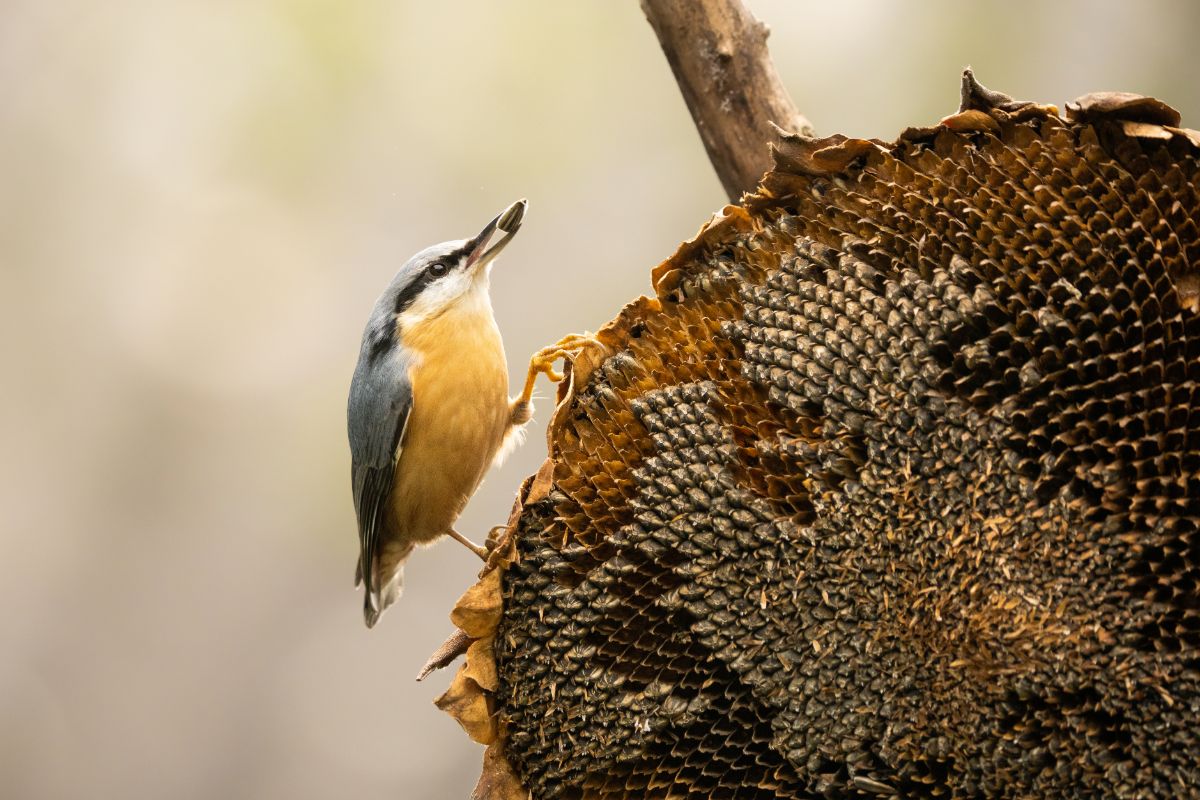
Many popular ornamental plants produce large seed heads towards the end of summer and into early fall. While these seeds can be gathered for seed saving or allowed to self-sow in your garden, you can also leave dried seedheads intact to feed songbirds and other wildlife throughout the winter months. In this guide, we’ll introduce you to an assortment of annuals and perennials that will yield large, protein-packed seeds that wild birds won’t be able to resist!
Jump to:
- 16 seed-bearing plants to grow for wild birds
- 1. Millet (Pennisetum glaucum)
- 2. Amaranth (Amaranthus spp.)
- 3. Coneflowers (Echinaceaspp.)
- 4. Black-eyed Susan (Rudbeckia hirta)
- 5. Goldenrod (Solidago spp.)
- 6. Bee balm (Monarda spp.)
- 7. Globe thistle (Echinops spp.)
- 8. Sunflower (Helianthus annuus)
- 9. Joe Pye weed (Eutrochium maculatum)
- 10. Aster (Symphyotrichumspp.)
- 11. Ornamental grasses
- 12. Blanket flower (Gaillardia spp.)
- 13. Alliums (Allium spp.)
- 14. Coreopsis (Coreopsis spp.)
- 15. Zinnias (Zinnia elegans)
- 16. Sea holly (Eryngium planum)
- Frequently asked questions
- What plants produce birdseed?
- Will birdseed grow if you plant it?
- What birdseed attracts the most birds?
- What is the best plant for attracting birds?
- What indigenous flora attracts birds to a yard?
- What flowers do birds like most?
- Summary
16 seed-bearing plants to grow for wild birds
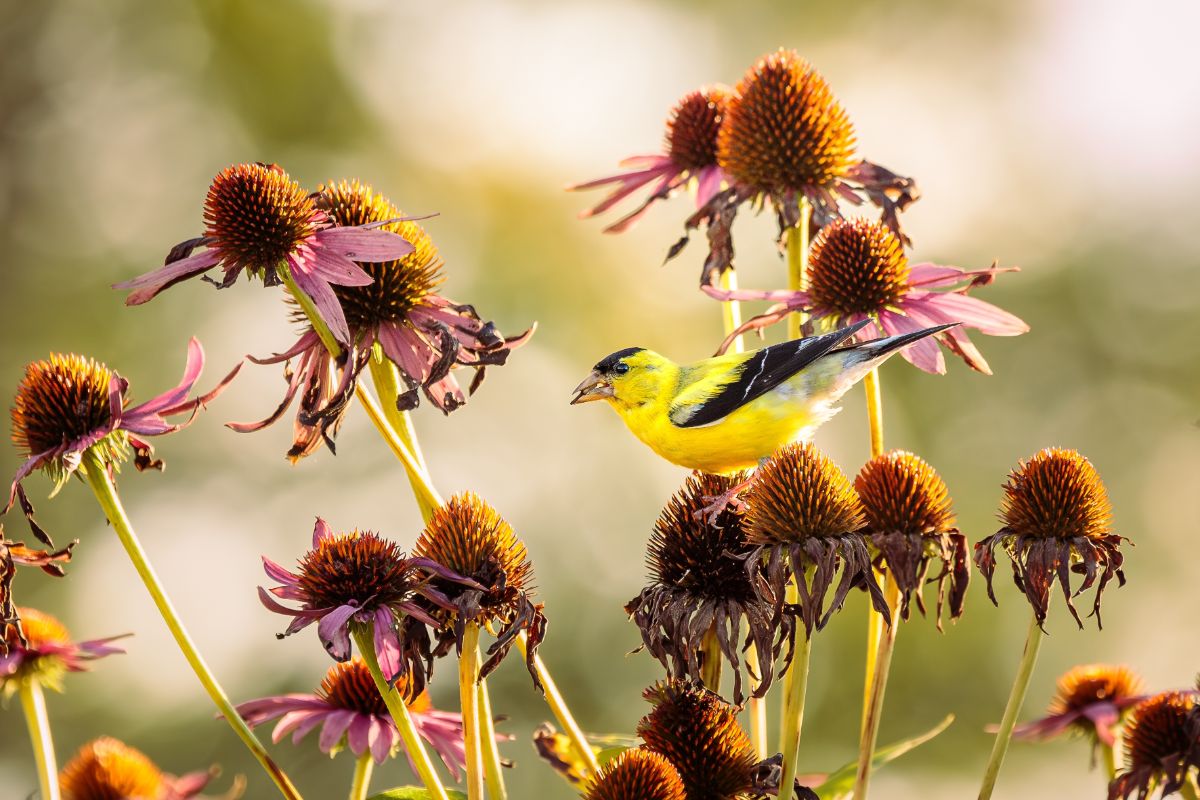
Growing native plants for birds is one way to make your garden more wildlife-friendly. But ornamental plants with large seed heads also serve as fantastic winter resources for birds when other foods are scarce. Combine these plants with a water source and some evergreen trees for shelter, and you can easily make a wildlife garden that will draw in songbirds and other critters even in the depths of winter!
1. Millet (Pennisetum glaucum)
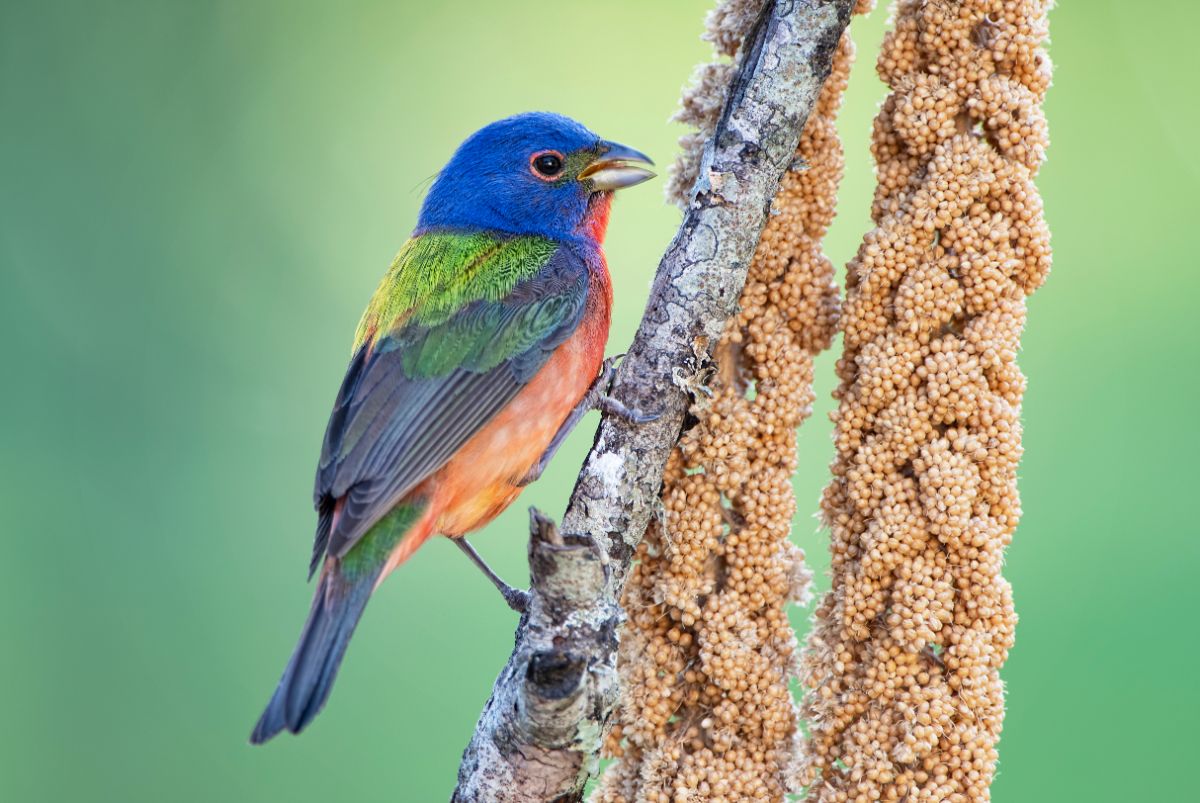
| Plant name: | Millet |
| Light requirements: | Full sun to part shade |
| Water requirements: | Moderate to low |
| Growing zone: | Zones 2 to 11 |
| Attracts: | Doves, juncos, house sparrows, Carolina wrens, thrashers, starlings |
There are many different species of millet plants, including highly ornamental cultivars with dark purple seed heads. However, pearl millet is a particularly popular choice since it’s easy to grow and attractive to boot. Most millet plants range in size from 5 to 8’ in height, but you can also find small specimens that will grow beautifully in pots and porch planters.
If you’ve been feeding backyard birds for a while, you know that most commercial bird seed blends contain millet seeds, and you can also purchase sprays of millet to feed birds in winter. But if you’re tired of buying seeds at the feedstore, you can grow your own millet and allow birds to forage for the seeds themselves. What’s more, millet plants make sculptural additions to gardens, and they look striking in dried floral arrangements, too.
2. Amaranth (Amaranthus spp.)

| Plant name: | Amaranth |
| Light requirements: | Full sun |
| Water requirements: | Moderate to low |
| Growing zone: | Zones 2 to 11 |
| Attracts: | Goldfinches and other seed-eating birds |
Amaranth is widely grown as an edible grain, but amaranths are also bewitching additions to garden beds. Varieties like “love lies bleeding” and red amaranth are famous for their brilliant red seed heads, which add late-season color to ornamental gardens and vegetable gardens alike. But when you’re done enjoying amaranth’s bold colors, you can leave the seeds in your garden to feed wild birds.
Most amaranths are annuals, and they won’t survive the winter. But even if you have lots of birds foraging in your amaranth seeds, these plants still readily self-sow, so you probably won’t need to plant more amaranth after you’ve sown a few seeds in your garden. As with millet, most amaranths are tall plants, growing between 4 and 6’ high, but you can also find dwarf cultivars that will fit in pots.
3. Coneflowers (Echinaceaspp.)
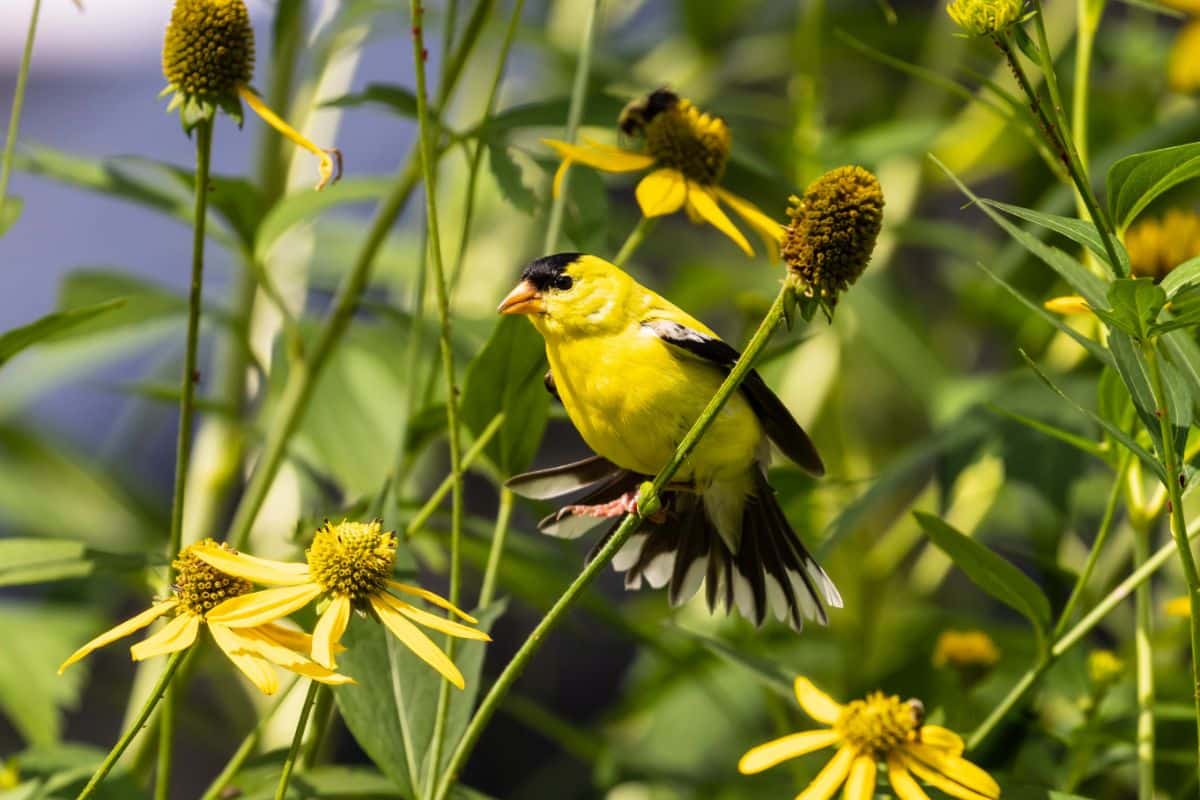
| Plant name: | Coneflowers |
| Light requirements: | Full sun to part shade (particularly helpful in hot regions) |
| Water requirements: | Moderate |
| Growing zone: | Zones 4 to 9 |
| Attracts: | Siskins, doves, chickadees, goldfinches, juncos, blue jays, cardinals |
Coneflowers are top pollinator plants that are well known for attracting bees and butterflies to garden beds. But if you allow coneflower blooms to dry on the plant after flowering, coneflower seeds can continue to attract wildlife to your garden… even in winter. Some of the birds that adore coneflower seeds include goldfinches and siskins, but you may also find large blue jays and cardinals feasting on these flowers as well!
Coneflowers look stately when they’re grown in clusters on their own, but coneflowers can also be interplanted with other bird-friendly plants, like black-eyed Susans, for a more nuanced garden design. While most gardeners are familiar with purple coneflowers, there are other colorful coneflower varieties to choose from, including the ever-popular yellow coneflower. Adaptable and cold hardy, coneflowers grow best in full sun, but these plants can also tolerate light shade and drought too!
4. Black-eyed Susan (Rudbeckia hirta)
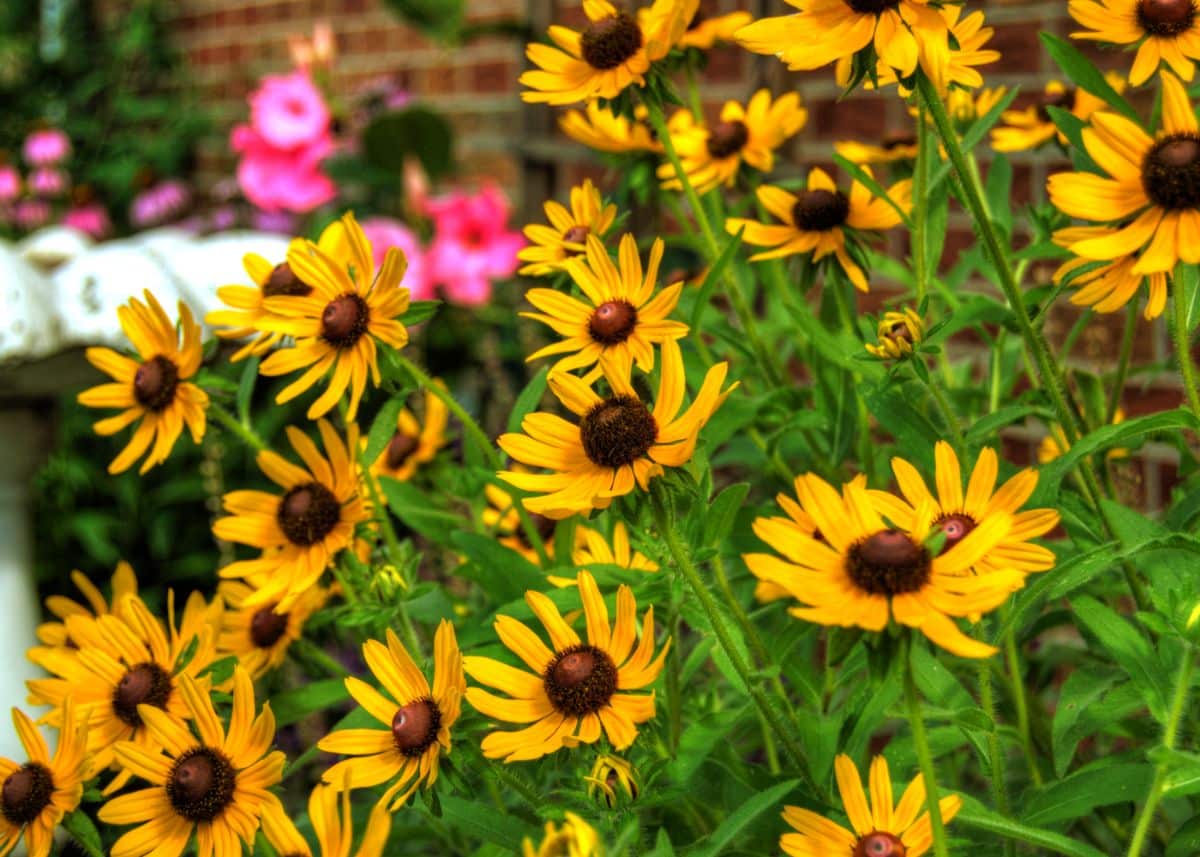
| Plant name: | Black-eyed Susan |
| Light requirements: | Full sun to part shade |
| Water requirements: | Moderate |
| Growing zone: | Zones 3 to 9 |
| Attracts: | Goldfinches, nuthatches, sparrows, chickadees |
Like coneflowers, black-eyed Susans are staples in pollinator habitats, but birds also can’t resist the large seed heads on these plants. In autumn and winter, you’ll often see an assortment of birds foraging for seeds on old black-eyed Susan blooms, and some of the most frequent visitors to these flowers are goldfinches. But although birds adore these flowers, black-eyed Susan plants still manage to be prolific self-sowers, which is great news if you want more free plants for your garden!
Most gardeners just grow a few black-eyed Susan plants in their flower beds. But if you love the look of black-eyed Susans’ golden orange petals, you can sow these plants en masse and create a small wildflower field to replace some of your turf grass. Black-eyed Susan seeds can be planted either in spring or autumn, and plants need minimal care and watering once they’re established.
5. Goldenrod (Solidago spp.)
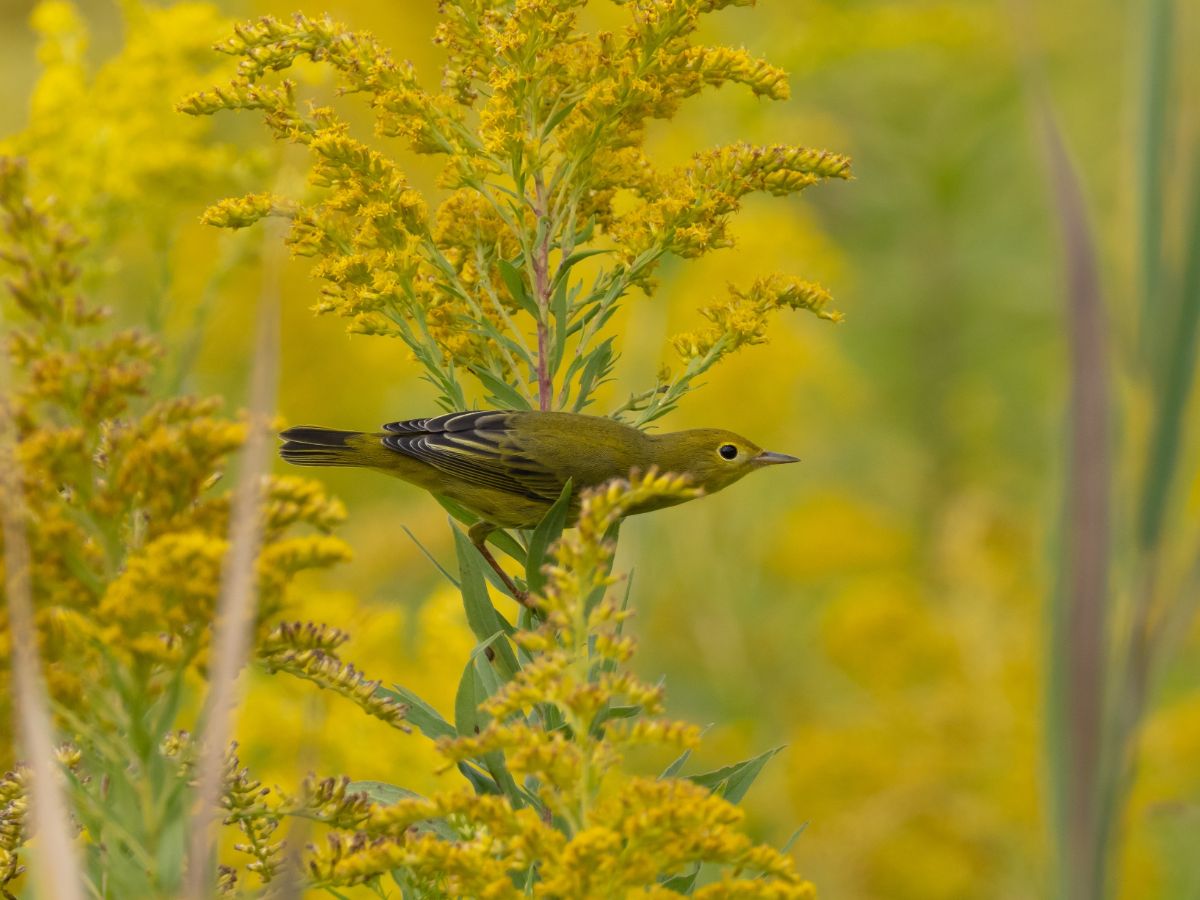
| Plant name: | Goldenrod |
| Light requirements: | Full sun to part shade |
| Water requirements: | Moderate |
| Growing zone: | Zones 4 to 9 |
| Attracts: | Carolina wren, goldfinches, chickadees, sparrows, titmice, juncos, indigo bunting, cardinals |
Goldenrod is another pollinator favorite, but when goldenrod’s brilliant yellow flowers fade, they give way to seeds that attract tons of birds. Most species of goldenrod are native to North America, and you can often find these plants growing wild along roadways and hiking trails. But if you’re creating a garden for birds, you can also purchase goldenrod seeds and start plants either in your garden or in pots for transplanting.
Some gardeners are reluctant to grow goldenrod because they associate this plant with seasonal allergies. However, most people aren’t actually allergic to goldenrod and, instead, allergy symptoms are produced by the similar-looking ragweed plant. If you’re new to working with goldenrod, you may not know that there are over 150 different species of goldenrod, including silverrod (Solidago bicolor), which has unique, silvery-white petals!
6. Bee balm (Monarda spp.)
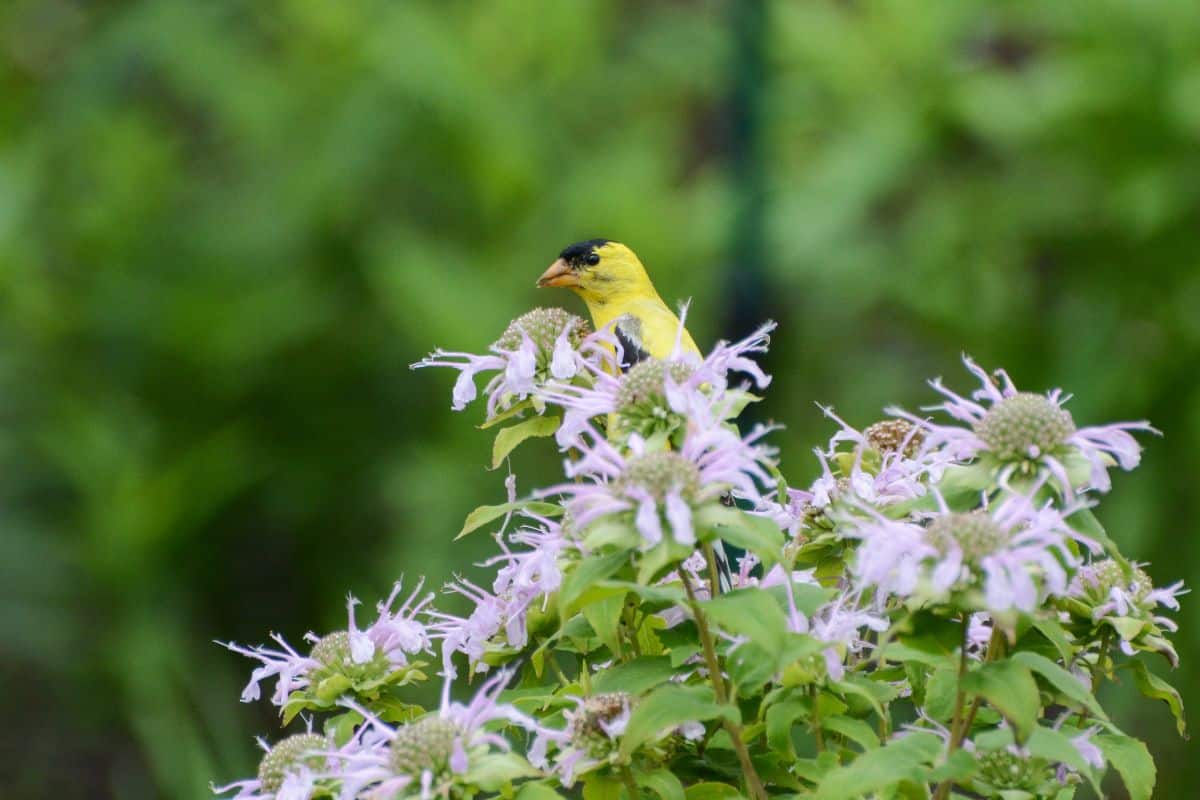
| Plant name: | Bee balm |
| Light requirements: | Full sun |
| Water requirements: | Moderate |
| Growing zone: | Zones 3 to 9 |
| Attracts: | Goldfinches, sparrows, and other seed-eating birds |
Bee balm is a member of the mint family, and it grows and spreads rapidly in garden beds. As a result, some gardeners choose to grow bee balm in dedicated raised beds or in containers where it’s less likely to take over. However, if your goal is to attract wild birds, you may not mind if your bee balm patch gets bigger every year!
Bee balm is known for its spiky flowerheads, which come in shades of pink, purple, red, and white. Those flowers are highly attractive to pollinators in summer, but birds love to feast on bee balm seeds in autumn, so you may not want to deadhead the flowers after they fade. Beyond their showy blooms, bee balm plants are also edible, and their leaves and flowers can be brewed into tea or used as garnishes and salad toppers.
7. Globe thistle (Echinops spp.)
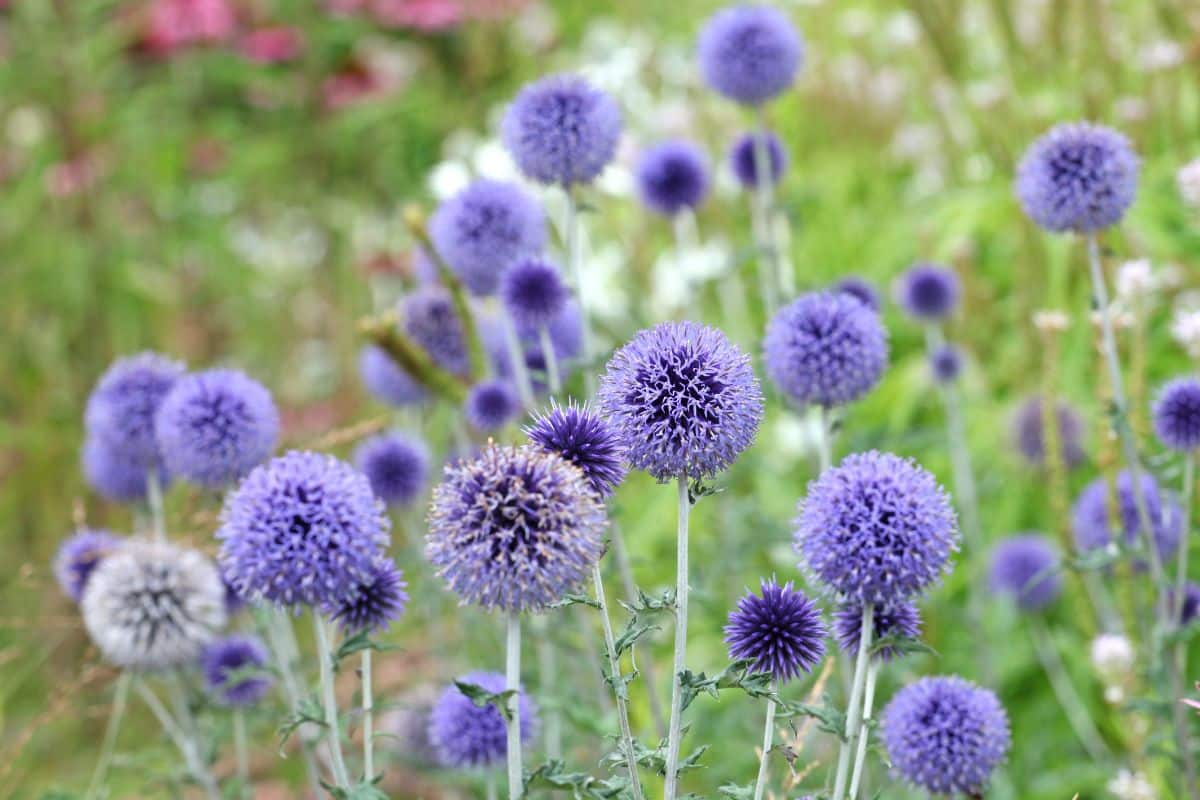
| Plant name: | Globe thistle |
| Light requirements: | Full sun |
| Water requirements: | Low |
| Growing zone: | Zones 3 to 10 |
| Attracts: | Indigo buntings, siskins, warblers, finches |
Goldfinches are some of the most ravenous, seed-eating birds, and many gardeners put out sock feeders brimming with thistle seeds to lure goldfinches to their backyards. But you can save on your bird seed budget by growing thistle plants in your garden and allowing wild birds to feed on them as they please. Many different thistles can be grown as ornamentals or medicinal plants, but the globe thistle is a particularly popular option that is commonly sold at most plant nurseries.
Globe thistle plants produce electric blue, globe-shaped flowers, which add interesting structure and texture to garden designs. Later in the season, globe thistle blooms can be gathered and displayed in dried floral arrangements or used in home craft projects. But make sure that you leave some globe thistle flowers behind in your garden for wild birds, too!
8. Sunflower (Helianthus annuus)
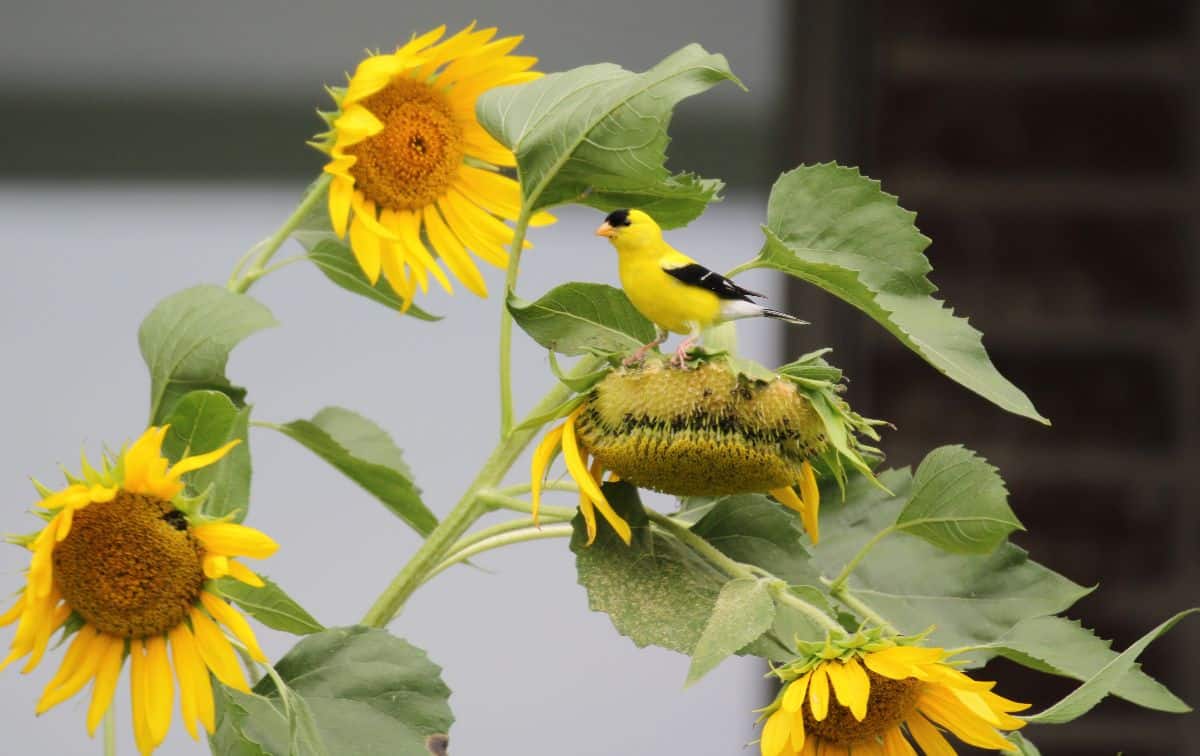
| Plant name: | Sunflower |
| Light requirements: | Full sun |
| Water requirements: | Moderate |
| Growing zone: | Zones 4 to 9 |
| Attracts: | Grosbeaks, blue jays, cardinals, chickadees, bluebirds, indigo buntings, blackbirds |
Sunflowers are summertime favorites, and many gardeners grow them for their edible flower heads, which can be roasted whole or dried for seeds. Sunflowers are also top choices for cut flower arrangements, and you can find pure white and deep maroon varieties that are perfect for bridal bouquets. But if you keep a bird-friendly garden, you may also want to grow sunflowers for wildlife!
Pollen-free sunflower varieties may be ideal for bouquets, but they aren’t as beneficial for pollinators. Instead, opt for large sunflower varieties, like ‘Mammoth Greystripe’ or black oil sunflowers, which are more attractive to birds. If you have a small garden or just a patio to grow plants on, you can also find dwarf sunflowers that pack all of the punch of large cultivars but in a much smaller package!
9. Joe Pye weed (Eutrochium maculatum)
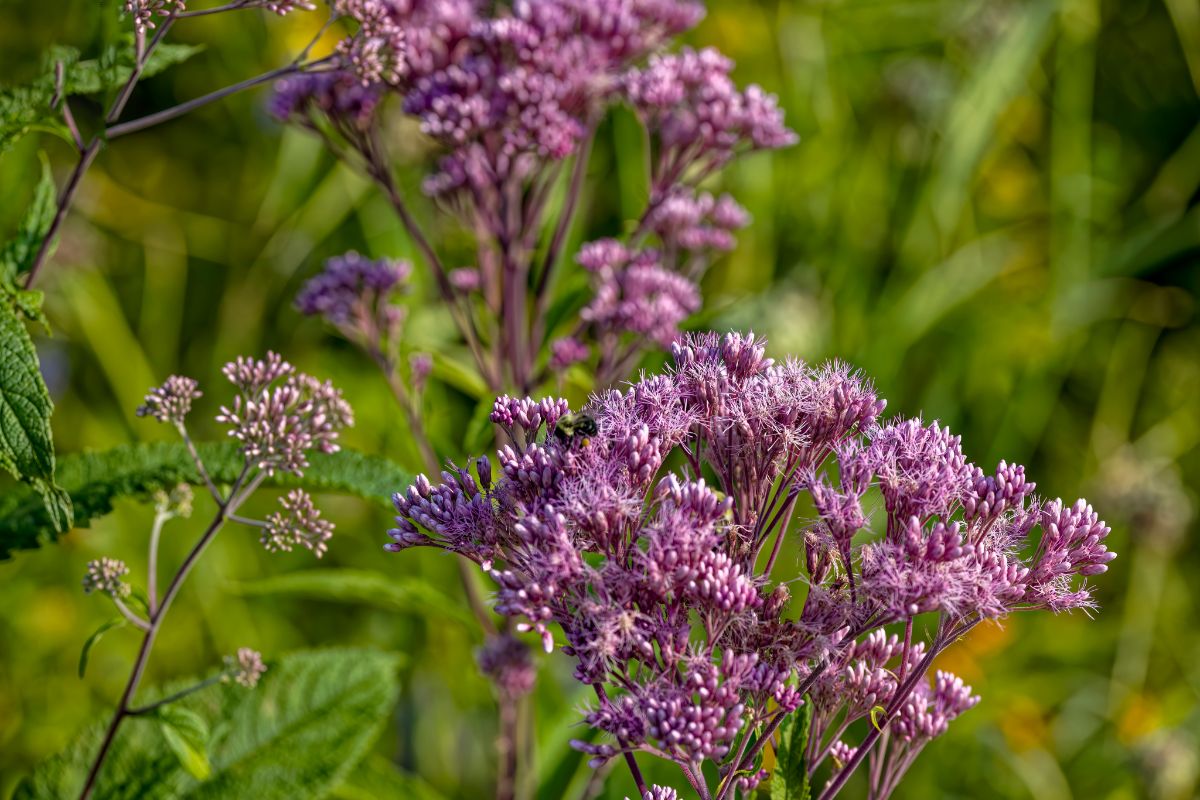
| Plant name: | Joe Pye weed |
| Light requirements: | Full sun to part shade |
| Water requirements: | High to moderate |
| Growing zone: | Zones 4 to 9 |
| Attracts: | Titmice, goldfinches, wrens, juncos |
Joe Pye weed plants are famously good at attracting pollinators. However, if you allow the flowers to go to seed, they can also draw in an assortment of wild birds, including titmice, juncos, and wrens. But if you want to get the most out of your Joe Pye weed plants, resist the impulse to cut back the flowerheads after they die back in the fall!
Joe Pye weed is a massive plant that can stretch over 8’ tall, so you will want to give it plenty of room to grow if you decide to keep it in your garden. On top of that, Joe Pye weed also craves lots of water, and it should be watered often in summer. While Joe Pye weed’s high water needs may make it a bit fussy in arid gardens, this plant is an ideal choice for soggy backyards and rain gardens, too!
10. Aster (Symphyotrichumspp.)
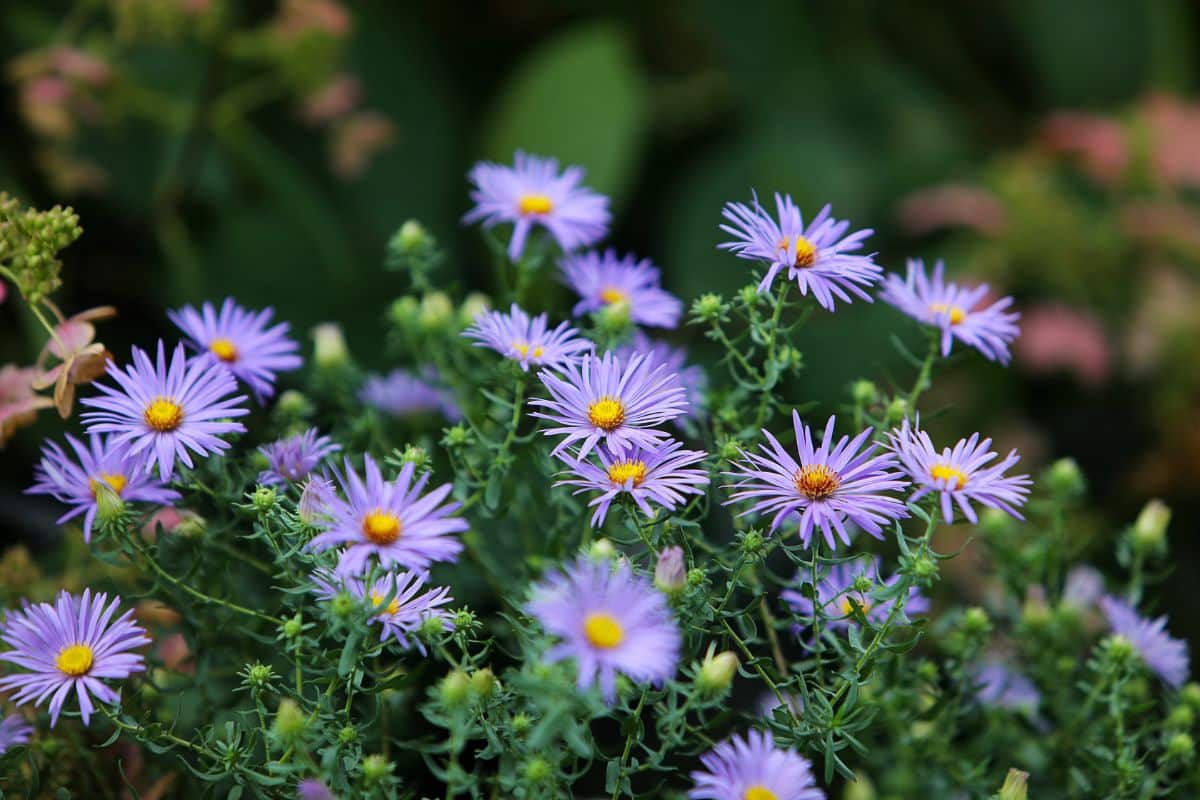
| Plant name: | Aster |
| Light requirements: | Full sun |
| Water requirements: | Moderate |
| Growing zone: | Zones 3 to 8 |
| Attracts: | Nuthatches, goldfinches, chickadees, towhees, blue jays, juncos |
Like goldenrod, asters are late-season bloomers that provide much-needed pollen and nectar to bees and other pollinators at the end of the summer and into fall. But after asters drop their petals, the center of the plant’s flower ripens into large seeds, which are always a treat for birds. Today, there are many types of asters to choose from, but New England asters are a particularly striking variety that’s native to much of the eastern United States.
Aster blooms usually sport either white or purple petals, but you can find varieties with pink and blue blooms, too. Depending on where you live, you can purchase pre-started aster plants at your local garden center, but asters are also easy to grow from seed. Even better, asters can tolerate full sun or part shade, and they’re adaptable to a range of soil types!
11. Ornamental grasses
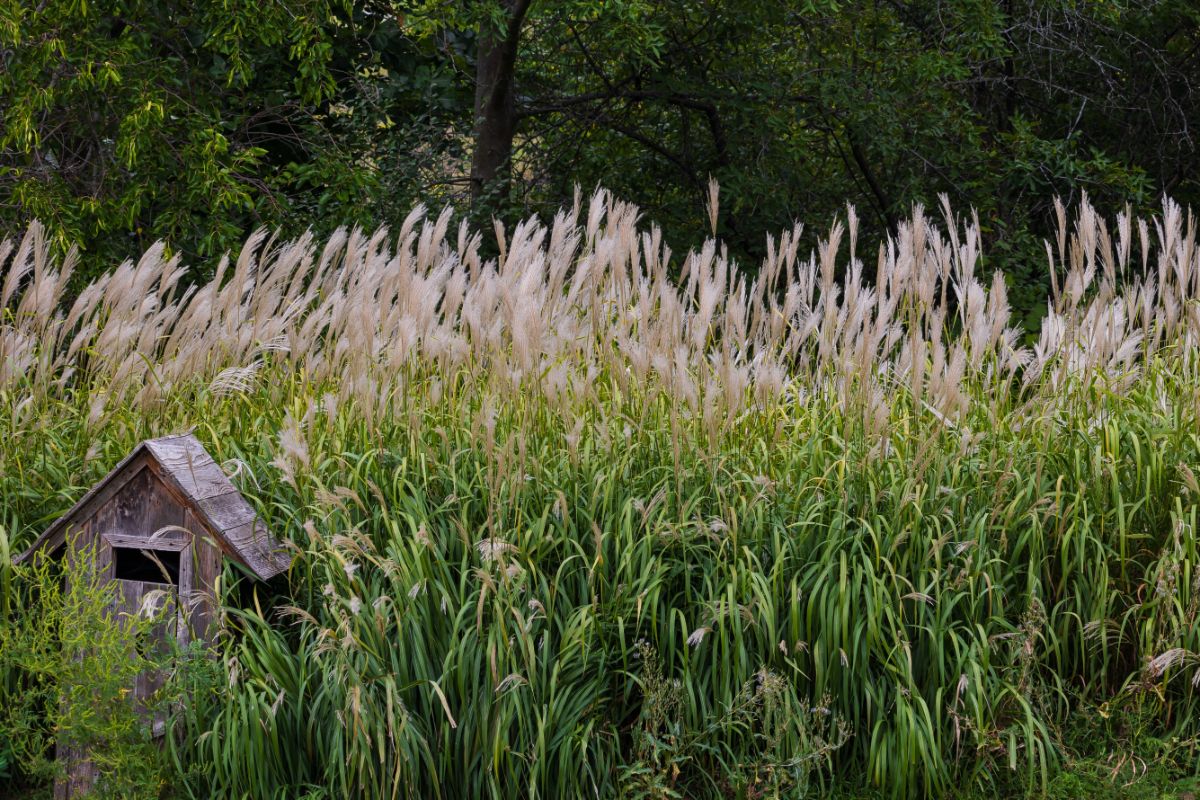
| Plant name: | Ornamental grasses |
| Light requirements: | Depends on variety |
| Water requirements: | Depends on variety |
| Growing zone: | Depends on variety |
| Attracts: | Quail, juncos, doves, finches, sparrows |
Many types of ornamental grasses stay upright during winter, which can provide texture and movement to garden beds when other plants have died away for the season. But beyond their long-lasting beauty, ornamental grasses also provide nearly year-round garden privacy, and many species produce large seed heads for wild birds as well. Some ornamental grasses can stretch well over 6’ tall, but you can also find shorter varieties that look stunning when planted towards the front of flower beds or along garden borders and walkways.
If you peruse the aisles of your favorite garden center, you’ll likely find many different ornamental grasses to choose from. Some popular choices include maiden grass, fountain grass, and feather grass, but if you want to attract birds, it may be best to stick to the native grasses that naturally grow in your region. In North America, some of the best native grass varieties to grow include blue grama, prairie dropseed, and little bluestem.
12. Blanket flower (Gaillardia spp.)
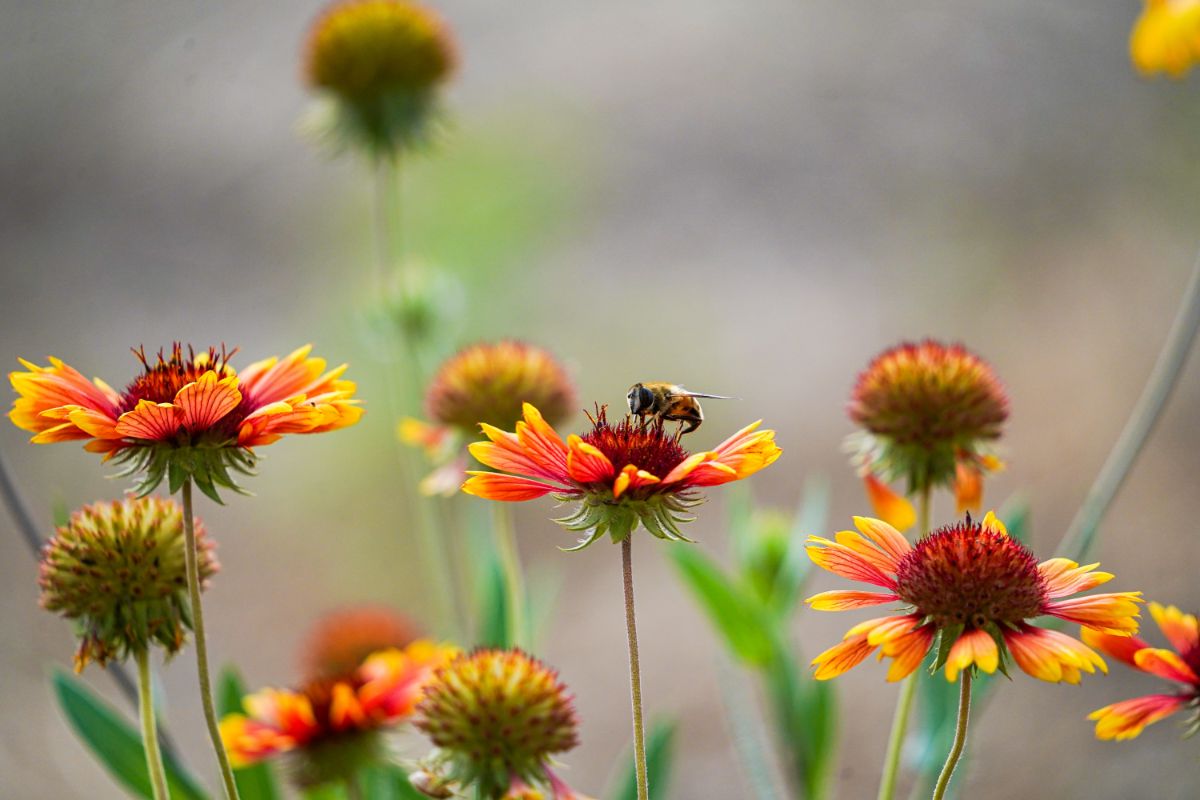
| Plant name: | Blanket flower |
| Light requirements: | Full sun |
| Water requirements: | Moderate to low |
| Growing zone: | Zones 3 to 10 |
| Attracts: | Various seed-eating birds |
Blanket flower is a fast-growing plant that forms a richly hued “blanket” of red and gold blooms as it spreads. Growing about 24 to 36” tall, blanket flower can hold its own in mixed garden beds, but it also looks becoming when grown en masse on its own. Even better, blanket flower is relatively drought tolerant once it's established, and this makes it a fine choice for gardens where water is scarce.
Easy to grow and reliable, too, blanket flowers yield long-lasting blooms, which are highly coveted by pollinators of all sorts. But once the petals drop and blanket flower blooms begin to droop, these plants beckon to seed-eating birds, such as goldfinches. While blanket flowers can be grown from nursery starts, these plants also sprout readily from seed, but they won’t bloom until their second year.
13. Alliums (Allium spp.)
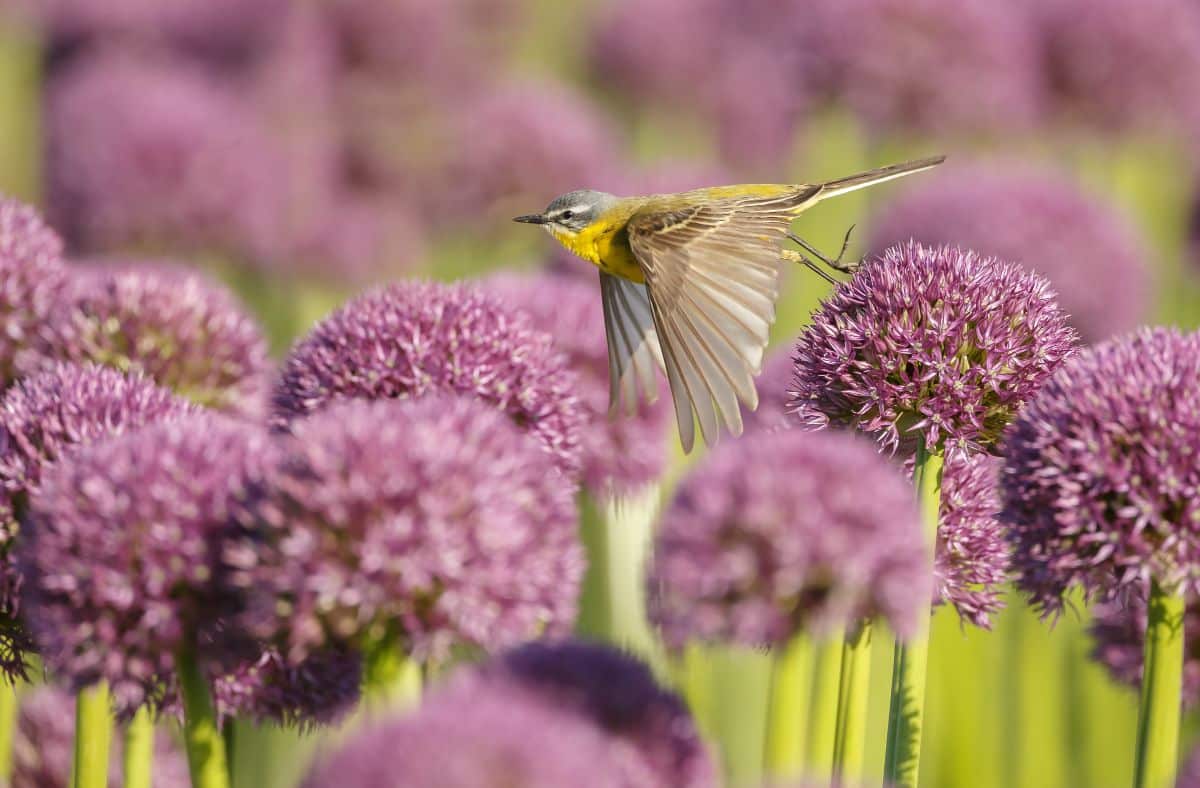
| Plant name: | Alliums |
| Light requirements: | Full sun to part shade |
| Water requirements: | Moderate |
| Growing zone: | Zones 3 to 9 |
| Attracts: | Assorted songbirds |
Ornamental alliums are closely related to garlic and onions, and their leaves have that oniony fragrance, which makes these plants naturally deer-resistant. But while garden pests typically leave alliums alone, alliums produce lots of tiny, black seeds after their flowers fade. Plus, when alliums’ ball-shaped flowers are in bloom, they’re absolute magnets for butterflies and bees!
Alliums are typically grown from bulbs that are planted in gardens in the fall and bloom in spring. But you can find an assortment of allium species with different bloom times, flower sizes, and colors. Alliums tend to flower immediately after tulips, and if you grow these plants in your garden, they can fill in that gap between spring-blooming flowers and summertime favorites.
14. Coreopsis (Coreopsis spp.)
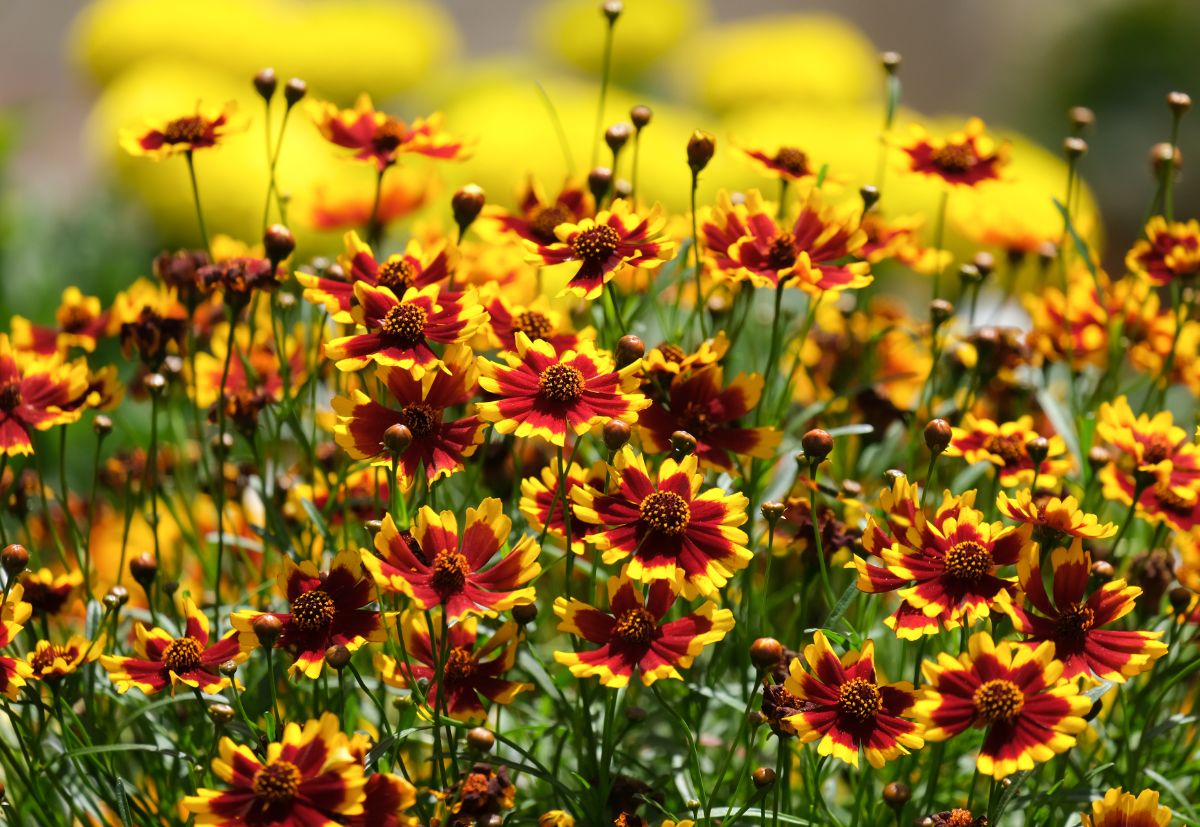
| Plant name: | Coreopsis |
| Light requirements: | Full sun |
| Water requirements: | Moderate |
| Growing zone: | Zones 4 to 9 |
| Attracts: | Cardinals, sparrows, chickadees, goldfinches |
Coreopsis is another prolific bloomer that flowers throughout summer and into fall. When coreopsis plants are happy, they tend to spread, which may not be a problem if you love coreopsis! However, if you prefer a more tidy garden space, you may want to locate coreopsis plants in a dedicated flower bed so they won’t look too “wild.”
Coreopsis plants readily self-sow if you don’t deadhead their blooms, and they also produce a plentiful bounty of seeds, which are favorite treats for many birds. Aside from attracting wildlife, coreopsis plants can also be used in crafting and to make homemade plant dye. Most often, you’ll find coreopsis with yellow and red flowers, but you'll find these plants with pink, white, purple, and bi-colored blooms as well.
15. Zinnias (Zinnia elegans)
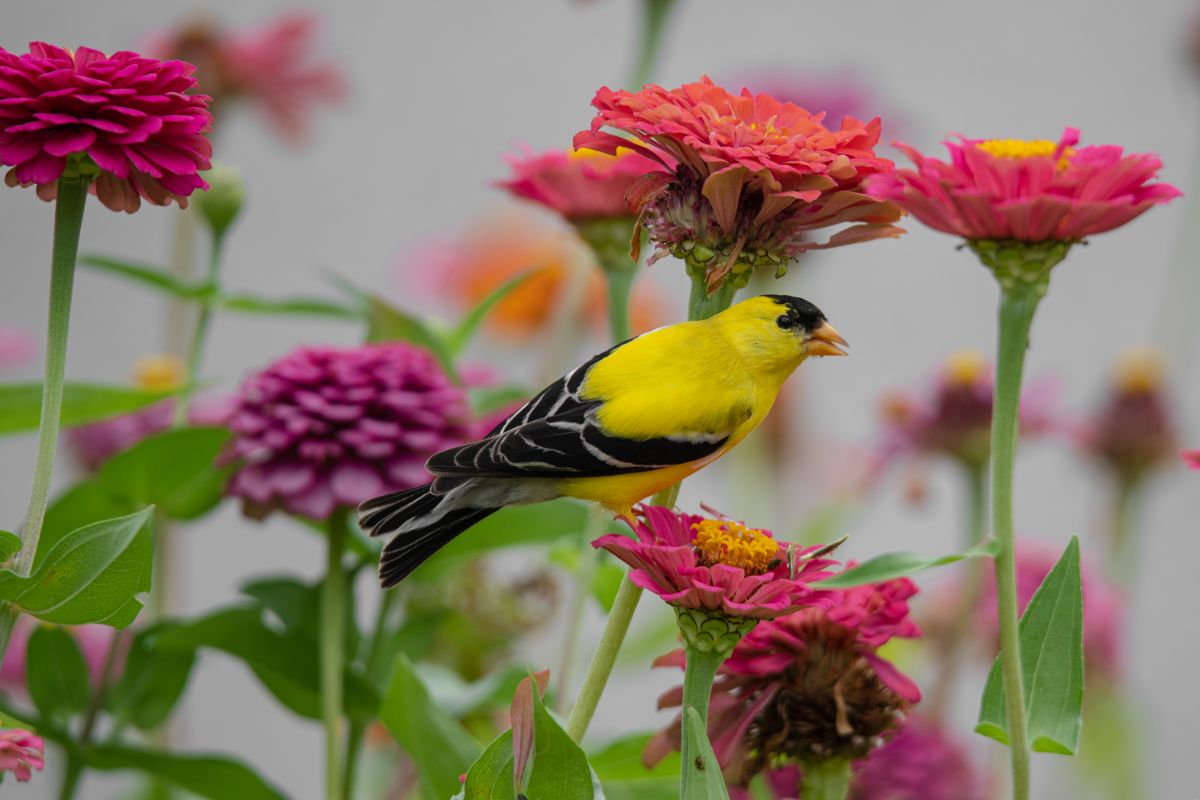
| Plant name: | Zinnias |
| Light requirements: | Full sun to part shade |
| Water requirements: | High to moderate |
| Growing zone: | Zones 2 to 11 |
| Attracts: | Finches, sparrows, siskins, cardinals, towhees |
Zinnias are often grown in vegetable gardens to keep pests away and to increase pollinator activity. But zinnias also make top-notch cut flowers, and if you leave the dried blooms in your garden in winter, their seeds will help to feed wild birds. However, if you keep a wildlife habitat garden, you’ll want to look for single (rather than double) bloomed zinnias, as these are more attractive to critters.
Zinnias come in a panoply of colors, including fuchsia pink, yellow, and orange. Some zinnias can stretch up to 4’ tall, and these tall specimens look striking when planted towards the middle of garden beds. But you can also find pint-sized dwarf zinnias that max out around 12” high and are ideal for garden borders and container growing.
16. Sea holly (Eryngium planum)
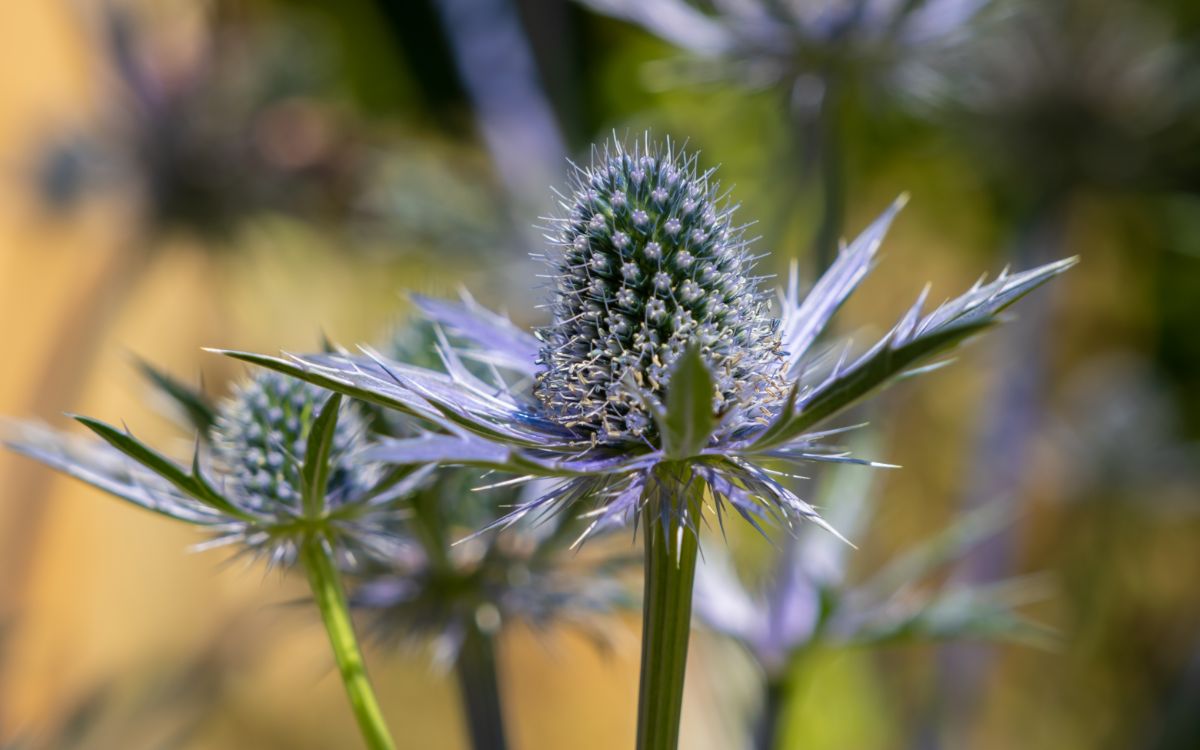
| Plant name: | Sea holly |
| Light requirements: | Full sun |
| Water requirements: | Low |
| Growing zone: | Zones 4 to 9 |
| Attracts: | Waxbills, sparrows, goldfinches, chickadees |
Sea holly has a unique look with spiky, thistle-like flowers that come in a steely blue color. In gardens, sea holly plants look divine when paired with other sculptural species, like bee balm and ornamental grasses. But you can also plant sea holly with low-growing groundcovers to create a layered garden effect.
One thing to keep in mind with sea holly plants is that these flowers do not transplant well, so you will want to think carefully about your planting spot. Once established, sea holly blooms abundantly from June to September, and sea holly flowers dry beautifully in preserved displays as well. But you may not want to preserve sea holly plants at all since the dried flowers are highly attractive to many bird species, including waxbills, sparrows, and goldfinches!
Frequently asked questions
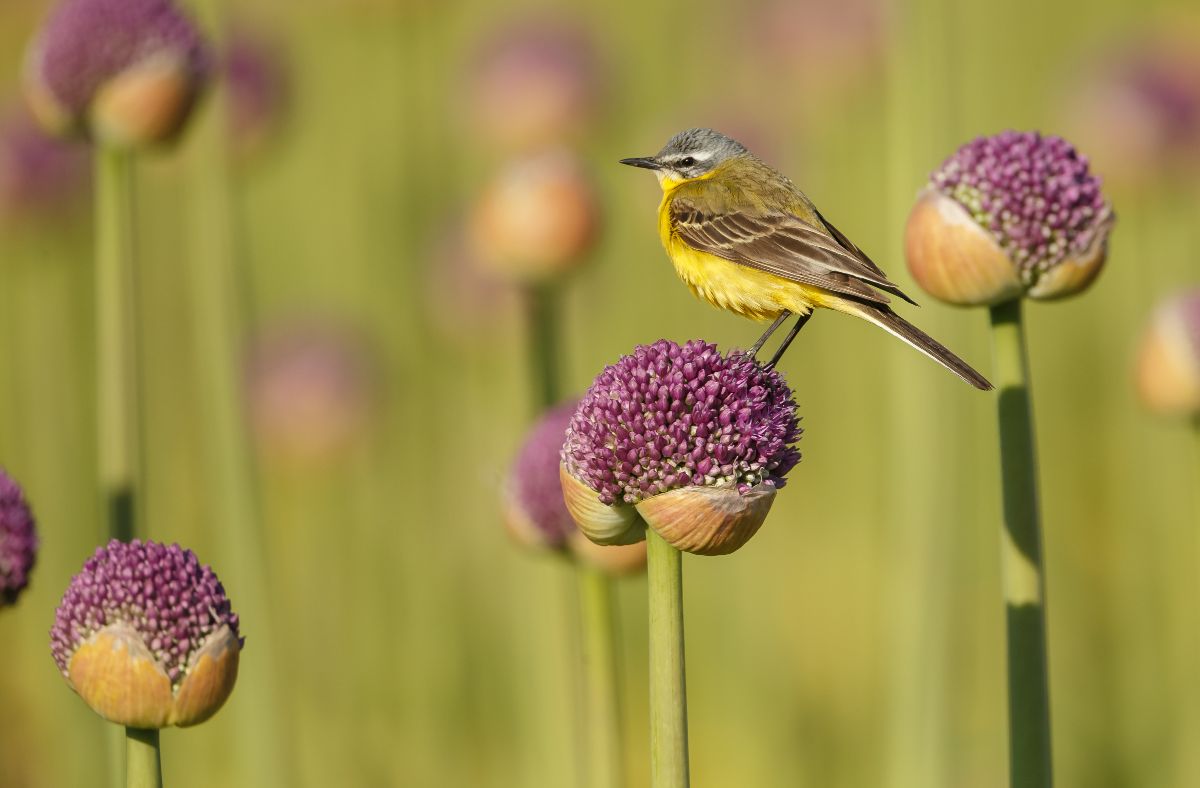
What plants produce birdseed?
Many different plants yield seeds that wild birds will happily gobble up. But the majority of commercial bird seeds are produced from a few specific plants, including millet and black oil sunflowers.
Will birdseed grow if you plant it?
Yes! Commercial bird seed blends typically contain viable seeds that will sprout if you plant them. That’s why you can often find “volunteer” sunflowers growing underneath bird feeders!
What birdseed attracts the most birds?
Different bird species are attracted to different varieties of bird seed; however, black oil sunflower seeds are known to be one of the most appealing bird seed types. These seeds are highly attractive to many different birds, including cardinals, chickadees, nuthatches, magpies, and siskins.
What is the best plant for attracting birds?
Aside from seed-bearing plants, plants that produce edible berries in winter are also attractive to birds. And, of course, evergreen trees are a must-have in any wildlife garden since their dense, evergreen branches provide some of the best natural shelter for birds during winter and in inclement weather.
What indigenous flora attracts birds to a yard?
Many different native North American plants will attract birds, including native evergreen trees, viburnums, and American holly. However, if you’re looking for native plants that will produce large seedheads for birds in fall and winter, some excellent choices include coneflowers, asters, goldenrods, and black-eyed Susans.
What flowers do birds like most?
Birds love plants with large flower heads and lots of seeds. That’s why sunflowers are one of the most appealing plants that you can grow for birds!
Summary

Setting out a bird feeder or two in winter is a wonderful way to help birds and other wildlife make it through the cold weather. But if you want to save money and grow a wild foodscape that will naturally provide everything birds need, you can also intentionally grow a bird-friendly garden that’s bursting with edible berries and nutritious seeds. The seed-bearing plants we’ve covered today are a great place to start, and beyond being wonderful resources for birds, they make aesthetically pleasing additions to gardens as well!
For more tips on keeping a wildlife habitat garden for birds, see our guide on heated bird baths or our recipe guide on making homemade treats for birds.


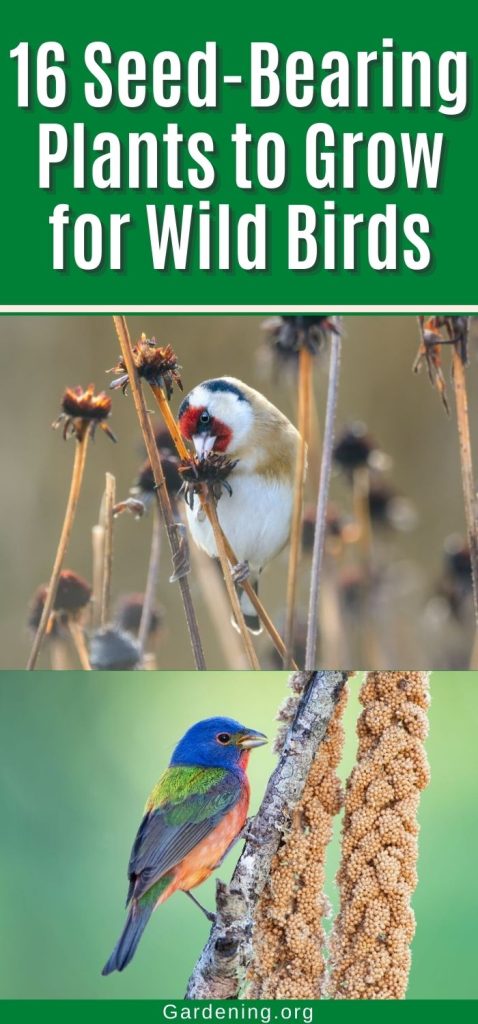
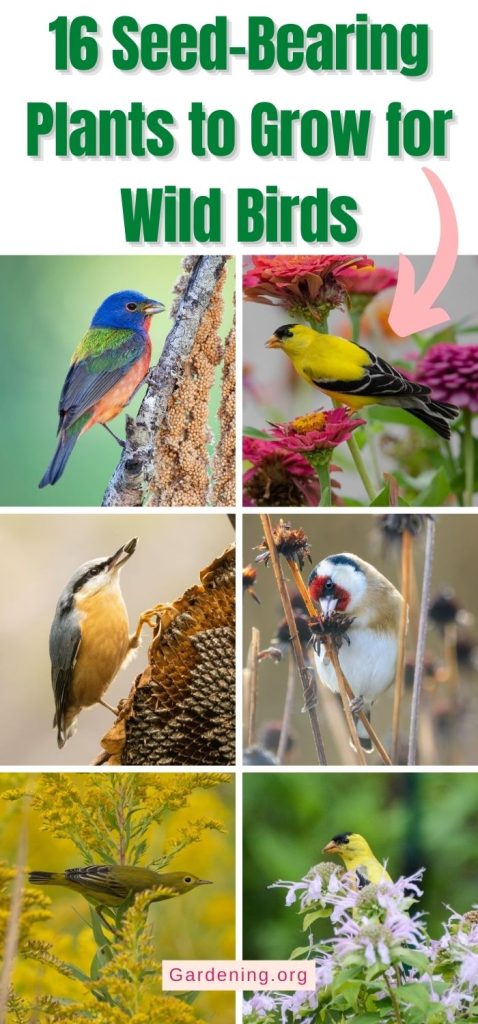
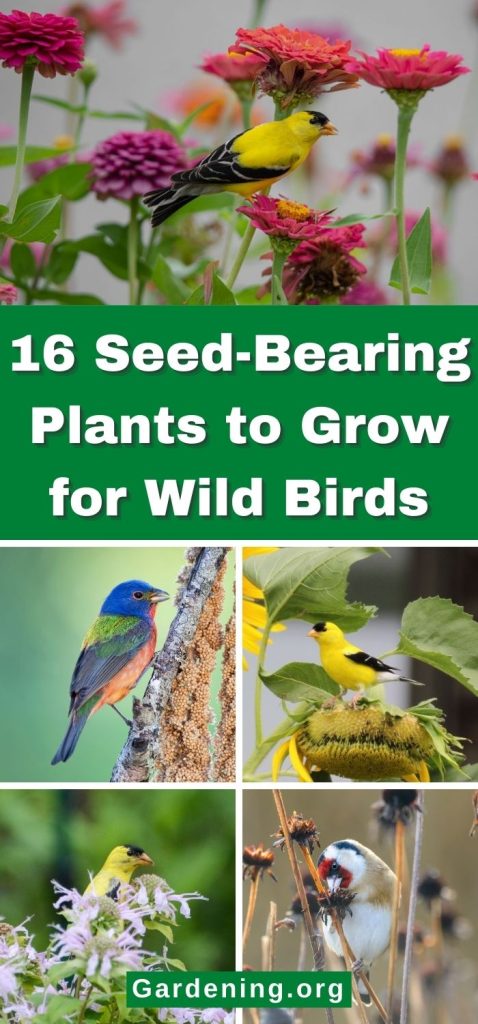
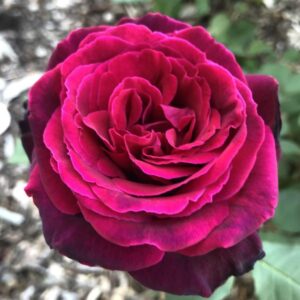
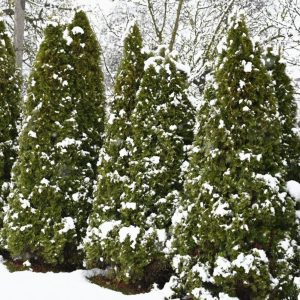


Leave a Reply